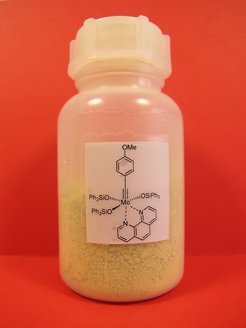Alkyne Metathesis

Olefin metathesis is undoubtedly one of the biggest success stories of homogeneous catalysis during the last decades and, as such, was rapidly embraced by the synthetic community. The related metathesis of alkynes, in contrast, is much less commonly used, even though the reaction benefits from a surprisingly strong driving force and is mechanistically fairly well understood. The classical alkyne metathesis catalysts are rather difficult to make, highly sensitive and therefore of limited significance.
Our group is committed to the design of new catalysts that are ought to combine high activity, excellent compatibility with functional groups, and ease of handling; only then can full advantage be taken from the inherent advantages of alkyne metathesis. An important step towards this ambitious goal was taken by the development of molybdenum alkylidyne complexes endowed with silanolate ligands. Complexes of this type are distinguished by high reactivity and an unrivaled tolerance towards polar and apolar functionality. As they can be stabilized by reversible adduct formation, easy-to-handle precatalysts are available to the practitioner.
Detailed spectroscopic and mechanistic investigations allow a detailed picture of the mode of action of these catalysts to be drawn. This information forms a sound basis for our attempts to improve the application profile and extend the substrate scope even further. An instructive example is the metathetic cleavage of the N-N triple bond of aryldiazonium salts.
In concert with the rich downstream chemistry of acetylene derivatives in general, alkyne metathesis provides ample opportunity for synthesis. Specifically, controlled semi-reduction reactions open entry into stereo-defined olefins; this approach shows distinct advantages over direct stereoselective alkene metathesis and is hence subject to intense study in our laboratory (see also: trans-hydrogenation, trans-hydrometalation). Equally relevant in this context is the activation of alkynes with the aid of carbophilic Lewis-acid catalysts.
In parallel work, our group is constantly exploring the scope of alkyne metathesis by applications to structurally complex and biologically relevant target molecules. The projects encompass alkaloids, glycolipids, macrolide antibiotics, peptides, prostaglandins etc. Prominent conquests are epothilone, the latrunculins, various amphidinolides, brefeldin, lactimidomycin, hybridalactone, tulearin, kendomycin, leiodermatolide, polycavernoside, mandelalide, enigmazole, lythranidine, disciformycin, nannocystin, callyspongiolide, rhizoxin, sinulariadiolide and spirastrellolide.
Additional information is available on our homepage “Natural Product Chemistry” and the following presentation.
Alkyne Metathesis
Contribution of the Fürstner Laboratory
